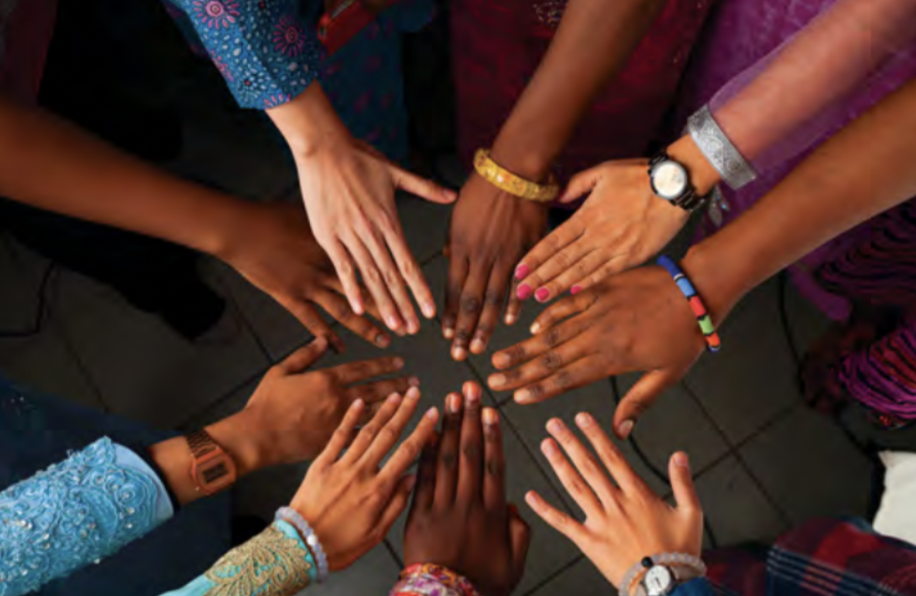This unfortunate reality’s prevalence among Muslims has implications for their education and mental health
By Hakim M. Rashid
January/February 2023
The brotherhood [and sisterhood] of Muslims mentioned in the Prophet’s (salla Allahu alayhi wa sallam) last sermon can, at a philosophical level, be considered an ideal in the minds of most Muslims. This pervasive ideal had a particular hold on the minds of African American reverts, thanks in large part to El Hajj Malik Shabazz’s (Malcolm X) transition from the Nation of Islam’s race-centered views to a Sunni Muslim worldview.
Viewing Islam as a psycho-cultural refuge from the U.S.’s unique brand of white supremacy, Muslim African Americans have often been quick to embrace their fellow Muslims, an embrace that has often overlooked the racism and colorism rampant in the latter’s homelands. While white supremacy has a uniquely European origin and quality (Frances Welsing, “The ISIS [YSSIS] Papers: The Keys to the Colors,” 1991), the Muslim world is no stranger to color consciousness and colorism.

India, Pakistan and Bangladesh
The Indian subcontinent, home to 500+ million Muslims, is historically and culturally rooted in the Hindu-based caste system, which views skin color as a measure of one’s worth. Colorism, evident in some of the ancient Vedic texts, established the later Hindu caste system of lighter-skinned Brahmans at the top and darker-skinned Shudras at the bottom.
This now-solidified color consciousness, which long predated the lighter-complexioned Mughal and even lighter-skinned English rulers, ultimately become an integral component of the Hindu nationalism that coexisted with British colonial rule. “Because race and language are commonly understood as ingredients of national identity, the idea of the Aryan race easily fed into the idea of the Indian nation… Indian nationalist discourse of the 19th century completed the development of the Aryan idea by equating the Aryan with the Hindu, and the Hindu with the Indian” (C. Upadhya, doi: 10.1177/0038022920020102, p.35). The result was the institutionalization of a previously unknown type of hierarchical color-based society.
Pakistan and Bangladesh remain entrenched within this system. For example, Asma Elgamal’s 2016 essay on tempest.co describes the pervasive use of skin whiteners in Pakistan based on her own experience, as does Maria Sartaj’s 2015 essay on www.dawn.com.
The same is true in Bangladesh. Golam Rabbani’s 2015 essay (https://en.ntvbd.com) states, “Apparently, our use of the Bangla word shundar, as a determiner, refers to someone with lighter skin tone. We use the word in a way which poses a discriminatory status, as if we are locating someone special within a crowd of average brown skin tones.”
Indonesia
In her “Seeing Beauty, Sensing Race in Transnational Indonesia,” L. Ayu Saraswati (2013) notes that the ancient symbolism of “lightness” and “darkness” as metaphors for good and evil, for enlightenment and ignorance, was transformed into simplistic notions of a skin color-based hierarchy. This basic Hindu belief entered the archipelago in the seventh century and became further entrenched as Hinduism spread via Java’s powerful Majapahit kingdom in the 13th century.
As early as the late ninth century, Aryan Indian domination of high culture and the ruling class had already imprinted its light-skinned beauty standard upon Java, as seen in the oldest surviving Indonesian literatures. When Dutch colonialism peaked in the 19th and through the early 20th century, preference for light skin was strengthened through specific gendered racial projects. Particularly since the late 1960s, U.S. popular culture has become one of the strongest influences in this regard.
Colonialism, Colorism and the Muslim World
Colorism, defined as the elevation of European standards of beauty and a psycho-cultural issue in the Muslim world, can largely be traced to European colonization’s economic (e.g., resource exploitation) and cultural (e.g., elevating European beliefs, values, attitudes and behaviors) consequences.
Tayyab Mahmud writes that “many foundational constructs of modernity — reason, man, progress, and the nation — were developed in contrast with a racialized ‘non-Europe,’ with the latter posited as pre-modern, not fully human, irrational, outside history. The process culminated in a modern grammar of racial difference, whose primary building blocks were the constructs of history and the development of liberalism against the backdrop of colonialism” (p.1221). Thus, by default, Europe “had the right, nay the duty, to govern other races, to impregnate them with reason, progress and the rule of law” (p.1223) (1999; digitalcommons.law.seattleu.edu).
Colorism Among Muslim Arabs
Arabs, who comprise approximately 20% of all Muslims, have an outsize impact due to the Arabic language, containing Makka and Madina and oil wealth. But to which race do they belong?
The region’s identification as a distinct land mass coincided with removing Arabs from their Afro-Asiatic roots. Rodolfo Fattovich and Lamya Khalidi’s research suggests that the “original” Arabs were dark-skinned and virtually indistinguishable from Ethiopians and Sudanese. The lighter complexions of the Arabian Peninsula’s current inhabitants is attributed to the migration of Turks and other more Caucasoid groups during the Ottoman Empire’s dominance, the ongoing influx of lighter-skinned people into the holy cities and the peninsula and their gradual supplanting of the darker-skinned Arabs.
In many ways, Egypt has become the Arab world’s prime example of colorism. Many Egyptians are loathe to consider themselves “African.” Sami Magdy, writing for apnews.com on Jan. 2, 2020, stated that centuries of colonization by Arab, Turkish and European imperial powers have caused lighter skin to be identified with the elite. Movies have long portrayed darker-complexioned Egyptians and sub-Saharan Africans as doormen, waiters and cleaners. Some Egyptians still unabashedly address people by their skin color: “black,” “dark” or “chocolate.” Historically, many have preferred to think of themselves as Arab, rather than African.
This colorism is most visibly manifested vis-à-vis Nubians, the original “Egyptians,” the people of the earliest Pharaonic dynasties and the population base of Nile Valley civilization (Cheikh Anta Diop, “The African Origin of Civilization: Myth or Reality,” 1974). There’s a clear distinction between Nubians and those Egyptians who consider themselves “white.”
Sudanese colorism manifests itself in the dual cultural identities of “Arab” and “African.” Many of the north’s predominantly Arabic-speakers see themselves as both, whereas others identify much closer with the Arabs of Egypt, Saudi Arabia and the Gulf.
In her March 5, 2008 article, Nesrine Malik describes the contradictions experienced by many Sudanese when navigating these dual identities: As a child, darker people were called ‘abd (slave). Moving to East Africa in the 1980s and despite being “blacks” of North African descent, he family seamlessly transferred ‘abd to the locals with whom they interacted, for “my family believed its Arab roots were somehow genetically dominant, giving us smaller features and a marginally lighter skin tone — thus deeming ourselves to be an entirely a different race from the ‘pure’ Africans” (www.theguardian.com).
Her self-identity was “cast into doubt” in Saudi Arabia: Skin color and the ability to trace one’s lineage back to the clan’s founding father determined one’s “Arabness.”
In her 2016 essay, Sudanese author Leena Habiballa remarks, “To be authentically Arab, it wasn’t enough to speak Arabic or have facets of Arab culture syncretised into my own. My Blackness needed to be invisible. … It wasn’t until my mid to late teens that I was forced to see Blackness and Arabness as ontologically separate. This was the result of being introduced to the Western concept of race” (mediadiversified.org).
Colorism and Arab Americans: Implications for Muslims
The U.S. Census Bureau classifies Arabs as thus “White,” and thus belonging to the racial group responsible for white supremacy and white privilege, denying Africans’ contributions to establishing a global civilization and perpetuating European beauty standards. Thus, many Muslim Arab Americans may have internalized their home countries’ imported colorism and express it here by manifesting the U.S.’s pervasive racism and colorism.
Khaled Beydoun, writing for www.aljazeera.com in 2015, states: “Far from merely a racial designation, whiteness still stands as the paragon of social citizenship in the US and a gateway to a myriad of privileges … Socially constructed in opposition to blackness, whiteness remains eternally associated with prestige, power, access, and opportunity … Early Arab immigrants desperately pursued whiteness and performed it in immigration proceedings. The law officially mandated whiteness as a prerequisite for US citizenship until 1952. Key judicial decisions in 1915 and later 1944, solidified the legal designation that Arabs were white by law.”
Conclusion/Future Directions
The Muslim world’s pervasive denial of color bias prevents an honest intra-Muslim dialogue about marriageability, social relations, economic development and other issues. Communities in Muslim-minority countries are excellent contexts to begin this dialogue, for they often comprise Muslims of varied ethnicities and skin colors.
National Muslim organizations might use the Unitarian Universalist Association’s “Examining Whiteness” (2015; www.uua.org) to analyze colorism’s destructive social impact. Only coordinated, multidimensional approaches — built on studying its roots in the Muslim world, the contributions of Africa and Asia’s ancient civilizations and white supremacy’s historical and cultural origins — that are integrated into education and mental health perspectives can eradicate this poison and lead to effective interventions.
Explicit anti-colorism hiring and advertising policies, along with local media outlet saturation, must be started. Qualified educators, researchers and mental health professionals should develop anti-colorist curriculum materials for all school grades and provide professional development training opportunities. Islamic scholars must speak out and publish their research on how to eradicate this scourge.
Muslims can help by placing colorism on the same level as eating pork, drinking alcohol or committing adultery. This color-based “less than” attitude has no basis in Islam and in a Muslim world that wishes to move forward in inclusive, productive ways.
Hakim M. Rashid is professor and former chairman of the Department of Human Development and Psychoeducational Studies, the School of Education, Howard University; former Fulbright Scholar at King Saud University; former Visiting Professor at Khartoum University; and a former Summer Fulbright Fellow in China. He received his master’s degree and doctorate from the University of Michigan in Ann Arbor.
Tell us what you thought by joining our Facebook community. You can also send comments and story pitches to [email protected]. Islamic Horizons does not publish unsolicited material.
